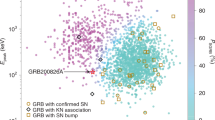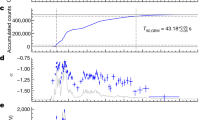Abstract
Long duration γ-ray bursts (GRBs) mark1 the explosive death of some massive stars and are a rare sub-class of type Ibc supernovae. They are distinguished by the production of an energetic and collimated relativistic outflow powered2 by a central engine (an accreting black hole or neutron star). Observationally, this outflow is manifested3 in the pulse of γ-rays and a long-lived radio afterglow. Until now, central-engine-driven supernovae have been discovered exclusively through their γ-ray emission, yet it is expected4 that a larger population goes undetected because of limited satellite sensitivity or beaming of the collimated emission away from our line of sight. In this framework, the recovery of undetected GRBs may be possible through radio searches5,6 for type Ibc supernovae with relativistic outflows. Here we report the discovery of luminous radio emission from the seemingly ordinary type Ibc SN 2009bb, which requires a substantial relativistic outflow powered by a central engine. A comparison with our radio survey of type Ibc supernovae reveals that the fraction harbouring central engines is low, about one per cent, measured independently from, but consistent with, the inferred7 rate of nearby GRBs. Independently, a second mildly relativistic supernova has been reported8.
This is a preview of subscription content, access via your institution
Access options
Subscribe to this journal
Receive 51 print issues and online access
$199.00 per year
only $3.90 per issue
Buy this article
- Purchase on Springer Link
- Instant access to full article PDF
Prices may be subject to local taxes which are calculated during checkout




Similar content being viewed by others
References
Woosley, S. E. & Bloom, J. S. The supernova gamma-ray burst connection. Annu. Rev. Astron. Astrophys. 44, 507–556 (2006)
MacFadyen, A. I., Woosley, S. E. & Heger, A. Supernovae, jets, and collapsars. Astrophys. J. 550, 410–425 (2001)
Piran, T. Gamma-ray bursts and the fireball model. Phys. Rep. 314, 575–667 (1999)
Perna, R. & Loeb, A. Constraining the beaming of gamma-ray bursts with radio surveys. Astrophys. J. 509, L85–L88 (1998)
Berger, E., Kulkarni, S. R., Frail, D. A. & Soderberg, A. M. A radio survey of type Ib and Ic supernovae: searching for engine-driven supernovae. Astrophys. J. 599, 408–418 (2003)
Soderberg, A. M., Nakar, E., Berger, E. & Kulkarni, S. R. Late-time radio observations of 68 type Ibc supernovae: strong constraints on off-axis gamma-ray bursts. Astrophys. J. 638, 930–937 (2006)
Soderberg, A. M. et al. Relativistic ejecta from X-ray flash XRF 060218 and the rate of cosmic explosions. Nature 442, 1014–1017 (2006)
Paragi, Z. et al. A mildly relativistic radio jet from the otherwise normal type Ic supernova 2007gr. Nature 10.1038/nature08713 (this issue)
Pignata, G. et al. in Probing Stellar Populations Out to the Distant Universe: Cefalu 2008 (eds Giobbi, G. et al.) 551–554 (AIP Conf. Proc., Vol. 1111, American Institute of Physics, 2009)
Pignata, G., Maza, J., Hamuy, M., Antezana, R. & Gonzalez, L. et al. Supernova 2009bb in NGC 3278. Cent. Bur. Electron. Telegr. 1731, 1 (2009)
Stritzinger, M., Philips, M. M., Morrell, N., Salgado, F. & Folatelli, G. Supernova 2009bb in NGC 3278. Cent. Bur. Electron. Telegr. 1751, 1 (2009)
Soderberg, A. M. The Many Facets of Cosmic Explosions. PhD thesis, Caltech (2007)
Kulkarni, S. R. et al. Radio emission from the unusual supernova 1998bw and its association with the gamma-ray burst of 25 April 1998. Nature 395, 663–669 (1998)
Chevalier, R. A. Synchrotron self-absorption in radio supernovae. Astrophys. J. 499, 810 (1998)
Li, Z. & Chevalier, R. A. Radio supernova SN 1998BW and its relation to GRB 980425. Astrophys. J. 526, 716–726 (1999)
Soderberg, A. M. et al. The sub-energetic γ-ray burst GRB 031203 as a cosmic analogue to the nearby GRB 980425. Nature 430, 648–650 (2004)
Chevalier, R. A. & Fransson, C. Circumstellar emission from type Ib and Ic supernovae. Astrophys. J. 651, 381–391 (2006)
Readhead, A. C. S. Equipartition brightness temperature and the inverse Compton catastrophe. Astrophys. J. 426, 51–59 (1994)
Tan, J. C., Matzner, C. D. & McKee, C. F. Trans-relativistic blast waves in supernovae as gamma-ray burst progenitors. Astrophys. J. 551, 946–972 (2001)
Hurley, K. et al. in Gamma-Ray Burst: Sixth Huntsville Symposium (eds Meegan, C., Kouveliotou, C. & Gehrels, N.) 55–57 (AIP Conf. Proc., Vol. 1133, American Institute of Physics, 2009)
Pian, E. et al. BEPPOSAX observations of GRB 980425: detection of the prompt event and monitoring of the error box. Astrophys. J. 536, 778–787 (2000)
Cappellaro, E., Evans, R. & Turatto, M. A new determination of supernova rates and a comparison with indicators for galactic star formation. Astron. Astrophys. 351, 459–466 (1999)
Dahlen, T. et al. High-redshift supernova rates. Astrophys. J. 613, 189–199 (2004)
Levesque, E. et al. The high metallicity explosion environment of SN 2009bb. Preprint at 〈http://ArXiv.org/abs/0908.2818〉 (2009)
Woosley, S. E. & Heger, A. The progenitor stars of gamma-ray bursts. Astrophys. J. 637, 914–921 (2006)
Modjaz, M. et al. Measured metallicities at the sites of nearby broad-lined type Ic supernovae and implications for the supernovae gamma-ray burst connection. Astron. J. 135, 1136–1150 (2008)
Law, N. M. et al. The Palomar Transient Factory: system overview, performance and first results. Preprint at 〈http://ArXiv.org/abs/0906.5350〉 (2009)
Kaiser, N. et al. Pan-STARRS: a large synoptic survey telescope array. Proc. SPIE. 4386, 154–164 (2002)
Perley, R. A., Napier, P. J. & Butler, B. J. The Expanded Very Large Array: goals, progress, and plans. Proc. SPIE. 5489, 784–795 (2004)
Blandford, R. D. & McKee, C. F. Fluid dynamics of relativistic blast waves. Phys. Fluids. 19, 1130–1138 (1976)
Acknowledgements
The VLA is operated by the NRAO, a facility of the NSF operated under cooperative agreement by Associated Universities, Inc. GMRT is run by the National Centre for Radio Astrophysics of the Tata Institute of Fundamental Research. This research has made use of the NASA/IPAC Extragalactic Database (NED) which is operated by the Jet Propulsion Laboratory, California Institute of Technology, under contract with NASA. A.M.S. and O.F. acknowledge support by NASA through Hubble and GSRP grants, respectively. E.M.L. is funded through a Ford Foundation Predoctoral Fellowship. R.J.F. is a Clay fellow. R.A.C. and R.P.K. acknowledge support through NASA and NSF grants. G.P. and M.H. acknowledge support from FONDECYT, Iniciativa Cientifica Milenio, FONDAP and CONICYT. A.R. and S.C. are funded by an 11th Five Year Plan Project.
Author Contributions All authors contributed extensively to the work presented in this paper.
Author information
Authors and Affiliations
Corresponding author
Ethics declarations
Competing interests
The authors declare no competing financial interests.
Supplementary information
Supplementary Information
This file contains Supplementary Notes and Data, Supplementary References, Supplementary Tables 1-3 and Supplementary Figures 1-2 with Legends (PDF 496 kb)
Rights and permissions
About this article
Cite this article
Soderberg, A., Chakraborti, S., Pignata, G. et al. A relativistic type Ibc supernova without a detected γ-ray burst. Nature 463, 513–515 (2010). https://doi.org/10.1038/nature08714
Received:
Accepted:
Issue Date:
DOI: https://doi.org/10.1038/nature08714
This article is cited by
-
Minutes-duration optical flares with supernova luminosities
Nature (2023)
-
A very luminous jet from the disruption of a star by a massive black hole
Nature (2022)
-
Radio Properties of Tidal Disruption Events
Space Science Reviews (2020)
Comments
By submitting a comment you agree to abide by our Terms and Community Guidelines. If you find something abusive or that does not comply with our terms or guidelines please flag it as inappropriate.



